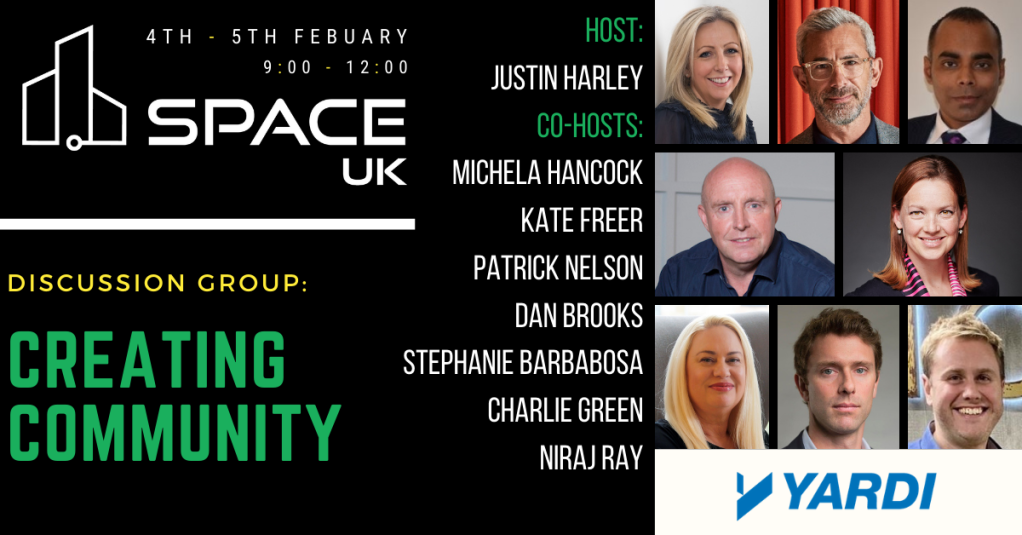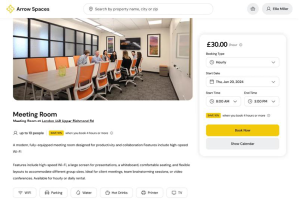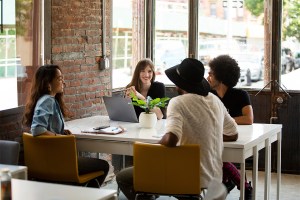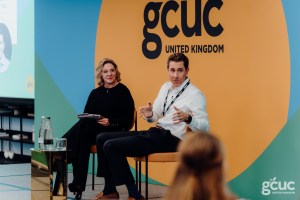Creating Community
Space UK, an alternative property event with a creative outlook on driving efficiency across all asset classes, was home to a vibrant discussion hosted by Yardi on ‘Real Estate as a Service – Creating Community’. Chaired by Justin Harley, Yardi’s regional director, the panellist line-up included:
The debate cross-compared the true meaning of community in the residential and flexible workspace markets and how to authentically achieve community.
- Stephanie Barbabosa, head of build to rent, Lendlease
- Charlie Green, co-CEO at The Office Group
- Niraj Ray, principal at Honeywell
- Kate Freer, head of UK investments at RealStar Group
- Michela Hancock, managing director at Greystar
- Patrick Nelson, head of international real estate at WeWork
- Dan Brooks, COO at Moda Living

What does community mean?
Harley opened the conversation asking what “community” meant to the panellists.
“Community is at the heart of what we do at WeWork,” Patrick Nelson of WeWork explained. “Part of building a great flexible workspace community is getting the foundations right. Ensuring the building operates correctly, creating warm and welcoming environments, and forming a global presence that allows members to travel to different cities whilst feeling happy and comfortable.”
Michela Hancock of Greystar portrayed the meaning of community from a residential perspective. Hancock explained that at Greystar they focus on comparing notes between how community is created in The States versus here in the UK. “One of the things we have changed since Covid is the addition of holding virtual events. We’re finding that more people are attending the online events than they did in person. We’re trying to create a more natural environment in events and work with the local communities to facilitate community growth.”
Harley pointed out that a sense of community in real estate is a fairly new concept, while Dan Brooks of Moda jumped in and commended WeWork for its pioneering leadership in creating communities.
Much like all of the panellists, Dan Brooks of Moda explained that community is at the core of everything Moda does, “If someone chooses your building as their home, it’s important that we respond to give them everything they need. Community is not achieved through forced fun. We offer a variety of activities to get residents involved to create friendships.”
Brooks also stressed the importance of extending the resident community to the wider local neighbourhood, “We put a lot of time into the neighbourhood. It’s easier for residents and local businesses to get involved with virtual events.”
Nurturing a sense of belonging and loyalty is fundamental in creating community. Many of the panellists explained that involvement in the wider local community is essential to the happiness of residents.
How do you foster community in your buildings?
“We stole our resident model from our operations in Canada to ensure we have a resident manager on site at all times,” commented Kate Freer of RealStar Group. At UNCLE, RealStar’s build to rent offering, they ‘do things differently’ according to Kate. Rather than offering events, they encourage residents to form their own community interactions. Kate explained that their residents are looked after by resident managers who act as caring ‘aunties and uncles’ to the residents.
Brooks of Moda agreed with RealStars approach, clarifying that there is more longevity in communities if events are initiated by the residents themselves.
A mix of people, buildings and technology
Stephanie Barbabosa of Lendlease was passionate in her belief that building a community derives from people, not buildings. “We spend a lot of time talking about our digital capabilities, but you need that great combination between people and technology to create community within a building,”
How has Covid changed office communities?
Charlie Green of The Office Group admitted that only in the last few years has TOG truly appreciated that community is about people, rather than the office space. “We ask ourselves, ‘how do we stay in touch and engaged with our members?’ Ultimately, we need to stay engaged with people and make them feel like they belong to something.” Green gave examples of how TOG has stimulated community engagement through the likes of furlough support training courses, cooking classes and yoga classes.
Green explained that there has been a shift in what type of people build a flexible workspace community. Several years ago, communities were made up of like-minded individuals who came to coworking spaces to generate revenue and business amongst each other, but it’s changed. According to Green, the flex space audience is much wider now and includes many corporate clients too. He explained that creating community isn’t about financial gain, it’s about avoiding financial losses.
Together, alone
In summary, community is driven in real estate through authentic engagement, without pressure to get involved. Stephanie Barbabosa reflected on a concept developed in the infancy of the build to rent market, where ‘together, alone’ meant residents could maintain independent living, in a community of other individuals. This is an idea she thought we should revisit to bring our communities together amidst the challenges of the pandemic.




